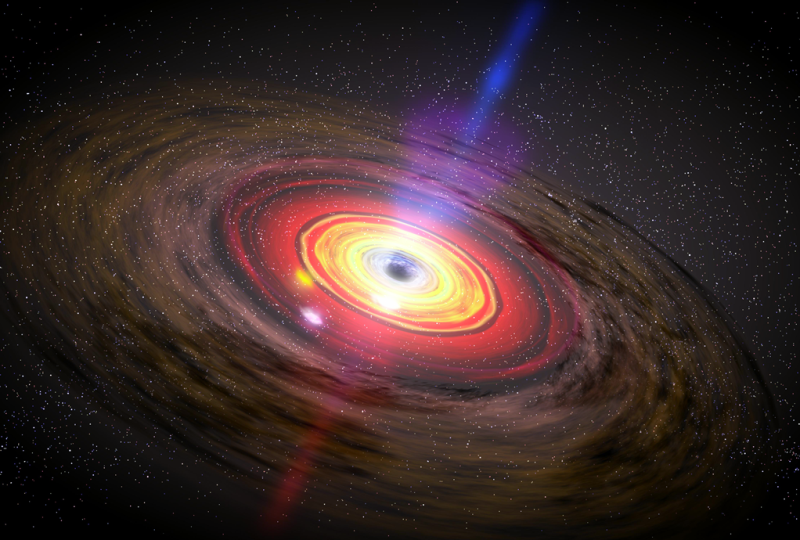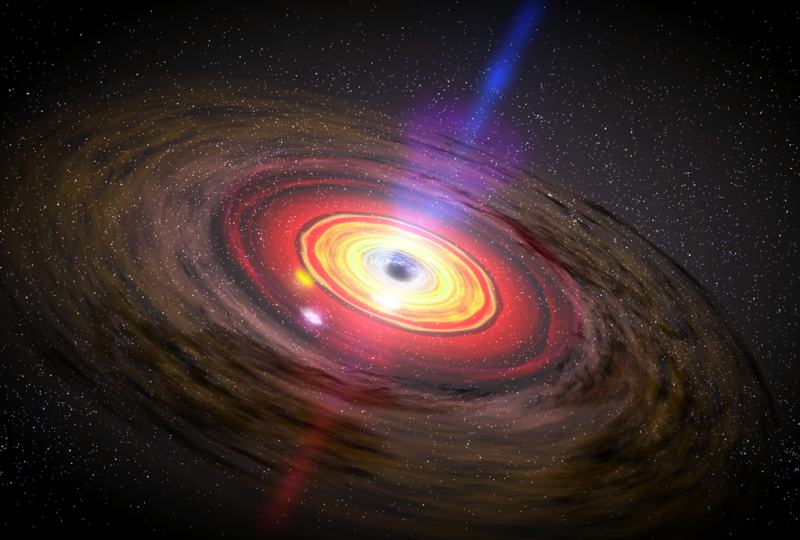Black Hole Assembly Line
Gravitational waves detected from some mergers of black holes suggest that the objects may be too massive to have formed directly from dead stars. Astrophysicists have proposed several scenarios by which multiple black holes might merge in a sequential fashion to produce larger black holes. Now researchers have shown using simulations that one of these scenarios, thought to occur in the centers of certain galaxies, should readily produce black hole mergers as large as those observed.
The LIGO and Virgo collaborations have publicly reported ten detections of gravitational waves from black-hole mergers. The simplest explanation for these events is that each one arose from a chance encounter between two black holes, remnants of dead stars, that became gravitationally bound and subsequently spiraled into each other. This scenario suggests that most mergers should involve black holes smaller than 40 solar masses, with 50 solar masses being highly unlikely. And yet, one of the recorded events had masses above this limit, and several more recent events—as yet unpublished—are rumored to be larger still.
Imre Bartos of the University of Florida, Gainesville, and colleagues have now simulated one prominent scenario that could explain the large observed black holes. This scenario—which had been considered before but without fully describing the implications—occurs in a so-called active galactic nucleus (AGN). This type of compact region exists near the centers of some galaxies that host a central supermassive black hole that is accreting material. The accretion disk contains gas, stars, and dust, as well as a collection of black holes.
Previous research suggested that gravitational interactions and other forces, such as friction from surrounding gas, will cause these black holes to migrate toward a ring at a certain distance from the center, about 300 times the supermassive black hole’s radius. Once the migrating black holes reach this ring,they become trapped there [1]. “It is kind of like a hurricane, where the eye has the lowest pressure, and things move towards it from all directions,” says Bartos. “Only in this case, the ‘eye’ is really a circle around the central supermassive black hole.” This circular migration trap, Bartos and colleagues believe, should bring black holes together and make mergers more likely.
To test whether this mechanism might really produce mergers as massive as those observed, Bartos and colleagues simulated the migration of black holes within a variety of AGNs having initial black-hole populations in line with observations. In the simulations, two black holes making their way to the migration trap could merge into a larger black hole, which, remaining stuck in the trap, might then merge again with another black hole. Each subsequent generation of black holes would be more massive than the previous one.
Through the simulations, the team estimated the probability distribution of the masses of black holes participating in mergers. They found that the AGN scenario produced many black holes much larger than 50 solar masses, with a few as large as 80 solar masses. They also showed that merging black holes often spin in the direction opposite to that of their spiraling orbital motion. This anti-alignment, which would be observable in the gravitational wave data, does not usually occur in other merger scenarios.
“This work provides a plausible mechanism to produce multiple mergers,” says astrophysicist Emanuele Berti of Johns Hopkins University in Maryland. He says multiple mergers can happen in dense stellar environments such as globular clusters, but these regions tend to lose their black holes. The reason is that a black hole created in a merger is usually spinning rapidly, and in subsequent mergers, such a high-spin black hole experiences a strong recoil that can eject it from the black-hole-dense region. However, a migration trap in an AGN can recapture these escapees. “If they exist,” says Berti, “migration traps are a reasonable mechanism to 'pile up' black holes and make them merge many times.”
Even so, both Bartos and Berti caution that this work doesn't entirely settle the mystery of large black hole mergers. Several other potential exotic scenarios may also produce large black holes. Researchers hope to use future observations from the Virgo-LIGO collaboration to look for signatures, such as anti-alignment of black hole spins, that could give evidence for the AGN scenario.
This research is published in Physical Review Letters.
–Mark Buchanan
Mark Buchanan is a freelance science writer who splits his time between Abergavenny, UK, and Notre Dame de Courson, France.
References
- J. M. Bellovary, M.-M. Mac Low, B. McKernan, and K. E. Saavik Ford, “Migration traps in disks around supermassive black holes,” Astrophys. J. Lett. 819, L17 (2016).





